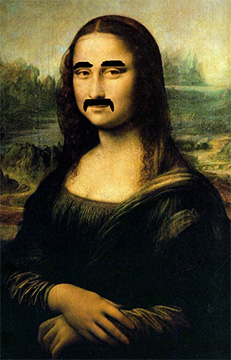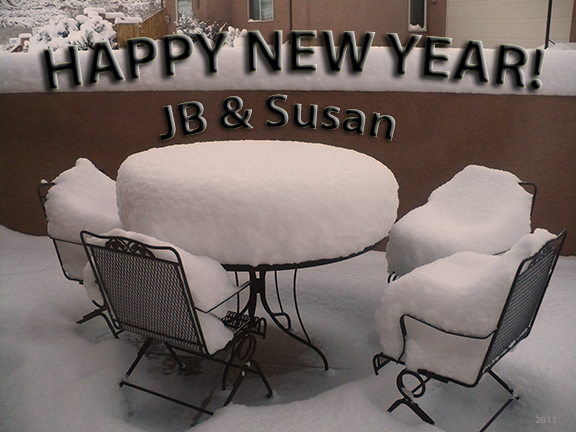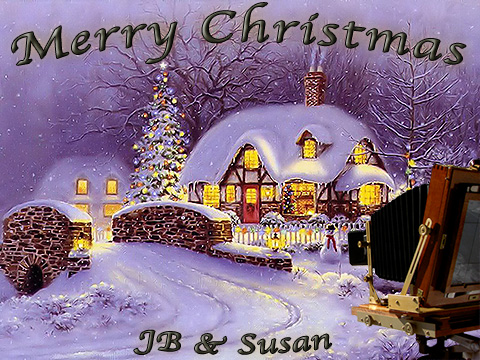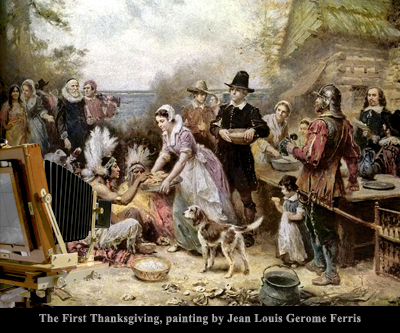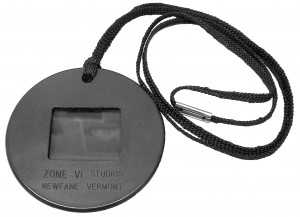HAPPY NEW YEAR!
FRAMED
 We recently had an interesting conversation with a local gallery curator and found that we unanimously agreed on one thing. Most art and all photography should be displayed in the most simple manner possible. Nothing is more distracting, and annoying, than an obnoxious presentation. Large, gaudy, frames with funky colored mats are just plain ugly. Our approach is to keep the presentation simple. The framing and mat should be completely transparent. It should only exist to isolate and protect the photograph. If you notice the frame and mat before you see the image, it is just not right. The KISS Principle (Keep It Simple Stupid) is the only way to display photographic art.
We recently had an interesting conversation with a local gallery curator and found that we unanimously agreed on one thing. Most art and all photography should be displayed in the most simple manner possible. Nothing is more distracting, and annoying, than an obnoxious presentation. Large, gaudy, frames with funky colored mats are just plain ugly. Our approach is to keep the presentation simple. The framing and mat should be completely transparent. It should only exist to isolate and protect the photograph. If you notice the frame and mat before you see the image, it is just not right. The KISS Principle (Keep It Simple Stupid) is the only way to display photographic art.
For us, you will not find any of our prints mounted and matted with anything other than pure white, acid free mat board. If we frame for exhibition, we use narrow black aluminum frames. The only other frame we would consider would be narrow natural finish maple. Our first choice for glazing would be glass, with acrylic as the second choice. That is it. Anything else is just plain gaudy and unnecessary.
So, just in case anyone is interested in the materials we use, here is a list;
• Light Impressions Westminster Bright White Buffered 100% Cotton Rag 4-Ply
• Frame Fit Co. Crestline Satin Black 9/32” Aluminum Frame plus Hardware
• Art Guard Glazing Products Plain Clear 2.5mm glass
• Wire & Cable Specialist SoftStrand Picture Hanging Wire #4
Those are the basic materials you will need. It is a good idea for you to learn to mount, mat, and frame your own photos. You should learn to cut your own mats. A Logan Simplex mat cutter is not excessively expensive and will serve you well for cutting simple window mats. The most expensive piece of equipment you need will be a good dry mount press. The Seal 210M is the workhorse of mount presses. Watch the auction sites and buy used, a Seal mount press will last a lifetime. This equipment is not extremely expensive and will pay for itself quickly. You will save a bundle of money and will have 100% control over the display of your art.
For more information, take a look at these articles; “DRY MOUNTING PHOTOGRAPHS” and “ADJUSTING THE DRY MOUNT PRESS” on our web site.
Remember, when it comes to displaying your art. . . simple. . . consistent. . . non-intrusive. . . is the look you want. If you are going to get framed, be sure to think simple!
JB
MERRY CHRISTMAS All
GETTING OUT
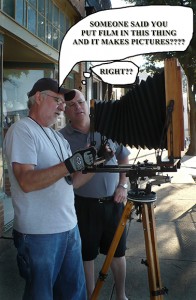 We are pleased, and honored, to have been invited to join a local, yet small, group of large format photographers this year. We have had numerous outings throughout the year around the area and had a really good time getting out to shoot some film and talk shop with a great group. Thanks to Eugene, Michael, Bob, Glenn and others. We are looking forward to more photographic adventures in the new year!
We are pleased, and honored, to have been invited to join a local, yet small, group of large format photographers this year. We have had numerous outings throughout the year around the area and had a really good time getting out to shoot some film and talk shop with a great group. Thanks to Eugene, Michael, Bob, Glenn and others. We are looking forward to more photographic adventures in the new year!
Our local large format photo group has proven to be a great test bed for new cameras. Moving to a new, lighter KB Canham 8×10 has served to lighten the load on the old back and should allow for even longer excursions into the wilderness. But the really exciting thing is the new ultra-light 11×14 camera and custom backpack designed by Susan. Now there is no excuse not to shoot 11×14 out of sight of the vehicle.
It is always fun to get out and shoot and our little informal group has made several trips into the field this year. Above is a photo of the 11×14 on its first outing. What a great time we all had. Thanks Michael for allowing me to use your cheery face in the photo!
JB
YET ANOTHER CAMERA PROJECT
 As much as I try to not talk continually about the gear, it seems that I always end up talking shop anyway. So, here I go again talking about another project. Having built two vertical pano cameras for Susan I promised myself no more camera building. Well, I do not seem to listen to myself all that well. I have this thing about big negatives. I have chosen the 8×10 to be my every day format. But there are times that I envision something just a little larger. In reality, my favorite format is 11×14, but the camera I have been using weighing in at about 24 pounds limits its usability. The idea of a more user friendly 11×14 has been rattling around in my head for some time. I spent a lot of time looking at various camera designs with particular interest in the lighter, more back friendly, cameras.
As much as I try to not talk continually about the gear, it seems that I always end up talking shop anyway. So, here I go again talking about another project. Having built two vertical pano cameras for Susan I promised myself no more camera building. Well, I do not seem to listen to myself all that well. I have this thing about big negatives. I have chosen the 8×10 to be my every day format. But there are times that I envision something just a little larger. In reality, my favorite format is 11×14, but the camera I have been using weighing in at about 24 pounds limits its usability. The idea of a more user friendly 11×14 has been rattling around in my head for some time. I spent a lot of time looking at various camera designs with particular interest in the lighter, more back friendly, cameras.
The nice thing about building your own, is you can pick and choose the features and design that best suits you. This is exactly what I did, and I ended up with a camera that is a conglomeration of designs.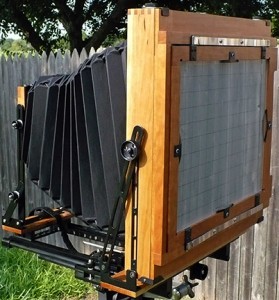
The end result is what I call the Ultra-Light 11×14. Here are the specs;
FORMAT — 11X14
FILM BACK — Horizontal/Vertical
BELLOWS — Max: 36.0” Min: 5.5”
FRONT SWING — Limited by Bellows
FRONT SHIFT — +/- 2.0”
FRONT RISE — +/- 3.0”
FRONT TILT AXIS — Limited by Bellows
FRONT TILT BASE — Forward: 45º Back: 90º
REAR TILT — Forward: Limited by Bellows Rear: 35º
REAR SWING — +/- 10º
GROUND GLASS — Acrylic
WOOD — Cherry
FRAME — Composite & Aluminum
FOLDED — 18” x 19” x 6”
WEIGHT — 13.5 lbs

FILM BACK — Horizontal/Vertical
BELLOWS — Max: 36.0” Min: 5.5”
FRONT SWING — Limited by Bellows
FRONT SHIFT — +/- 2.0”
FRONT RISE — +/- 3.0”
FRONT TILT AXIS — Limited by Bellows
FRONT TILT BASE — Forward: 45º Back: 90º
REAR TILT — Forward: Limited by Bellows Rear: 35º
REAR SWING — +/- 10º
GROUND GLASS — Acrylic
WOOD — Cherry
FRAME — Composite & Aluminum
FOLDED — 18” x 19” x 6”
WEIGHT — 13.5 lbs
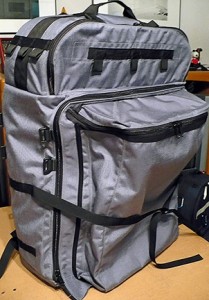 The most important thing here is the last item, Weight! Once all of the camera was finalized, Susan had to build a pack to haul everything. Took several weeks, but I now have a complete 11×14 packable camera system. The pack carries the camera, three lenses, accessories, three film holders, and weighs in under 45 pounds!
The most important thing here is the last item, Weight! Once all of the camera was finalized, Susan had to build a pack to haul everything. Took several weeks, but I now have a complete 11×14 packable camera system. The pack carries the camera, three lenses, accessories, three film holders, and weighs in under 45 pounds!
Now it is time to get out and get back to what is important, making photographs. This, I hope, will be my last camera building project.
JB
P.S. Take a look at my previous post titled, “THE VIEW CAMERA IN THE FIELD” November 25th, for another photo of the Ultra-Light 11×14 with pack on its second outing.
DON’T FORGET TO WRITE SANTA
THANKSGIVING
THE VIEW CAMERA IN THE FIELD
This Is How We Work With A View Camera.
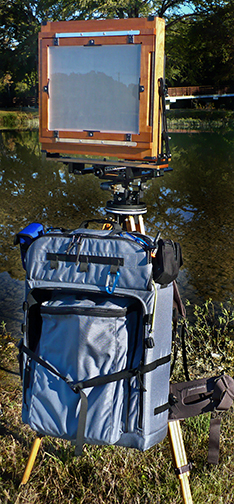 There is always a lot of discussion on how best to carry LF gear in the field. Seems that most people like to carry their camera in a backpack. That is our favorite mode of transportation in the field for sure. We like the backpack idea so much that Susan builds our packs to custom fit our cameras and accessories. All that we have learned about camera packs has been worked out the hard way. We have copied the features of commercial packs that we find useful and modified as required.
There is always a lot of discussion on how best to carry LF gear in the field. Seems that most people like to carry their camera in a backpack. That is our favorite mode of transportation in the field for sure. We like the backpack idea so much that Susan builds our packs to custom fit our cameras and accessories. All that we have learned about camera packs has been worked out the hard way. We have copied the features of commercial packs that we find useful and modified as required.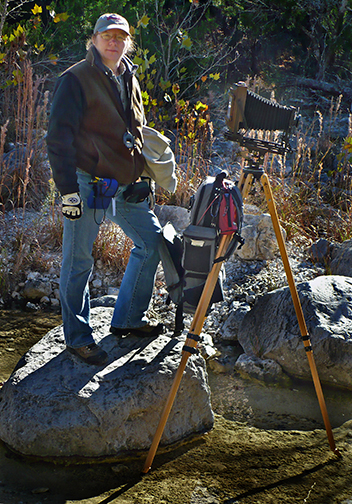
It seems that most people plop their pack down on the ground when they get ready to shoot. That is fine, unless you are in mud, water, or knee deep in snow. I have never liked the idea of setting my pack on the ground. And, yes I know, there are those that carry a tarp, but that is way too much trouble for me. I want to find my subject, plop down my tripod and then get to work without having to look for a convenient and safe place to put down the pack. This thinking led to a modification to both the tripod and the pack. Susan added a webbing loop to the top of the pack and I added a hook on the bottom of the tripod crown. This allows us to hang the pack from the tripod, keeping it out of the dirt and making it very accessible.
We both have worked out a system that allows us to carry everything we need and work efficiently in most any situation. The packs we use have a large compartment in the bottom for the camera and a separate top compartment for lenses and accessories. The custom packs also have room for several film holders.
This is how we do it and it has proven to be very efficient. However you choose to work in the field, the most important thing is to have everything you need with you, well protected, and easily within reach.
JB

